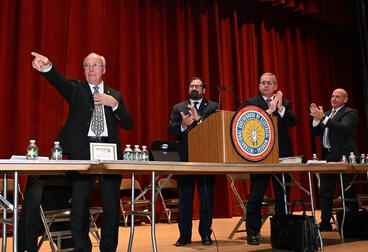In 1967 New York City there were an average of 450 births and 250 deaths each day increasing the population of the city by 73,000 people a year while it was declared that 3 million people were already living in unsuitable housing. The problem of inadequate low-income housing had existed for decades in New York City and was trending the wrong way.
In his speech to the Consumer Assembly on January 15,1967 Harold Ostroff, the Executive Vice-President to the United Housing Foundation outlined “the terrible need for more housing at prices people can afford, the impact of slums upon the lives of both young and old, the future of low and moderate cost housing in our city and the achievements of the United Housing Foundation in developing moderate-cost housing projects.” Mr. Ostroff saw public housing as the crux of the city’s problems in 1967 that branched out into all areas of its residents lives‰ÛÓtransportation, industry, educational, cultural and recreational facilities‰ÛÓamong others.
Mr. Ostroff praised the mild achievements that the Foundation had enjoyed thus far with its rehabilitation of slum areas in Manhattan’s Lower East Side and Harlem and its success in creating housing complexes such as Rochdale Village in Jamaica, Queens. Ostroff said that the State’s Limited Profit Housing Companies Law has demonstrated the effective partnership needed between private entity corporations and government that resulted in the then-under construction Big Six Towers and Co-op City.
However, Mr. Ostroff claimed not enough was being done to fulfill the need for adequate affordable housing with the Foundation becoming complacent and too self-satisfied with developing too few complexes like Rochdale Village, Co-Op City and Stuyvesant Town. “The real tragedy of the housing situation is, that I’ve know what has to be done to meet the situation, we have the tools to do the job‰ÛÓbut we lack the courage‰ÛÓthe guts‰ÛÓto move ahead,” Ostroff says.
Since 1937, Ostroff reported that an incalculable amount of billions of dollars had been spent to clear up slum neighborhoods and create new, affordable housing with limited success. “More dollars have been spent for low and middle income housing in the City of New York than in any city in the nation. But the stark fact is that today millions of New Yorkers simply do not have adequate living. Tragically we have lived so long with this ignominious situation that we tend to become immune to the human implications of the meanings of tenements, slums,
ghettos on the lives of people both young and
old.”
Ostroff cited the Logue report which was an independent commission about affordable housing in the city when he says that New York City ranks first in dollar amounts received in Federal grants for urban renewal. On a per capita basis however, the city had spent only $31 compared to $458 in New Haven, CT. The city had spent $109 million for land grants under the “Title I” program, which if had been comparable to New Haven’s spending would have accounted to $1.5 billion dollars towards affordable housing in 1967.
Mr. Ostroff saw that building a better city involved fixing the problem of affordable housing with economically integrated housing, superior educational opportunities, development of industries and businesses around neighborhoods, adequate cultural and recreational facilities in low-income areas and a working partnership between private companies and government to make it happen.
A continuing downward trend and neglect of the fact to the need of more affordable housing worried Ostroff, correctly, that some day the Landmarks Commission will designate the quaint streets in our city, like those around Wall Street and around Greenwich Village areas, as historic landmarks, which has come to fruition. Mr. Ostroff even speculated that one day some developer will examine the 249 cemeteries in the city that totaled 4,166 acres of tax-exempt land valued at $167 million as viable options to fix the complex problem.
Almost 50 years later and New York City still finds itself amidst an affordable housing crisis with a larger income disparity than ever before and more dire circumstances for the trade unions who are no longer guaranteed to build them. Mayor de Blasio unveiled an ambitious housing policy that seeks to create 200,000 units of affordable housing over the next ten years making it one of the largest plans of its kind.
Initiated in the 1970’s as an incentive for developers to build affordable housing units, the 421a program has evolved into a tax exemption for obscenely wealthy, large developers to build exclusionary luxury residential units throughout New York City. If anyone wonders why their parents, relatives and friends are being financially squeezed out of their old neighborhoods, 421a is a large part of the reason. Developers are immune to the tax increase consequence of their new construction but not the existing community.
According to the 421a program, after tax exemption for developer’s new construction units, condos and coops sell at real estate market rates with registered rent stabilized units also listed at market rate prices, defeating affordability. This neglect of affordable housing is the phenomenon that Harold å_Ostroff reported on in 1967 that was already a scourge dislocating people of lesser means from adequate housing or a suitable place anywhere to live. As market rate residential construction experiences an unprecedented boom in New York City, which contractors signatory to the Building Trades of NYC are often excluded from bidding lists, those who cannot afford the consequence of rent soaring neighborhoods are squeezed from their residences.
421a is inconsistent at best and the tax obligations that are waived for builders range in lengths of time beginning at a minimum of 10 years and up to as much as 25 years without any return to the city. Developer tax abatements cost the city over $300 million annually with tax losses increasing with every new high rise project. To add insult to injury, for average New Yorkers the facts are: prevailing rate is not protected under 421a; workers cannot afford to purchase the residences they build; and developers have enjoyed projected profits exponentially increase as prices rise during construction.
We must, as Mr. Ostroff said in 1967, know what has to be done to meet the situation, have the tools to do the job but not lack the courage or the guts to move ahead.
The following is the complete article by Mr. Ostroff:

